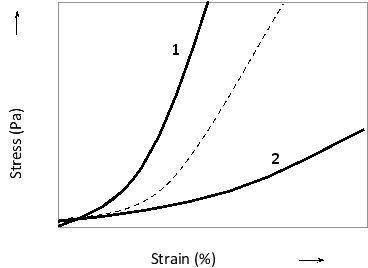Question 24
(Short Answer)
The elasticity of the components of the extracellular matrix can be visualized in a stress-strain curve, in which the tensile stress (corresponding to load) applied to a tissue sample is plotted against the strain (corresponding to deformation) measured in the tissue. In the following stress-strain graph, the elasticity of an intact connective tissue is represented by a dashed curve. The other two curves correspond to the same tissue that has been treated with either formic acid (to digest collagen) or trypsin (to digest elastin). Which curve (1 or 2) do you think corresponds to trypsin treatment?

Answer
The elastic fibers (composed of elastin...
View full Answer